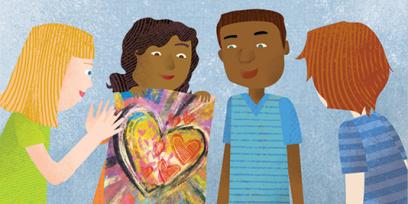Adverse childhood experiences (typically referred to as ACEs) are potentially traumatic experiences and events, ranging from abuse and neglect to parental incarceration.* A growing body of research has made it increasingly apparent that ACEs are a critical public health issue that can have negative, lasting effects on health and well-being in childhood or later in life.1 However, more important than exposure to any specific event of this type is the accumulation of multiple adversities during childhood, which is associated with especially deleterious effects on development.2
One mechanism responsible for the effects of ACEs—toxic levels of stress—can be substantially buffered by stable and supportive relationships with caregivers. Schools and educators can also play a critical role by promoting these kinds of caring relationships, as well as social and emotional skills, that support healthy youth development for all students; removing exclusionary and punitive disciplinary practices; and supporting the physical and mental health needs of students.3
Prevalence of Adverse Childhood Experiences
There is growing interest in understanding the prevalence of these adverse experiences across different communities in the United States, as well as their implications for families, schools, and other child-serving institutions. A recent Child Trends research brief, The Prevalence of Adverse Childhood Experiences, Nationally, by State, and by Race/Ethnicity, from which this article is drawn, used data from the 2016 National Survey of Children’s Health (NSCH) to estimate the prevalence of one or more selected adversities among children from birth through age 17, as reported by a parent or guardian. The study team estimated the national and state-level prevalence of eight specific adversities: parental divorce or separation, death of a parent, parental incarceration, witnessing violence in the home, experiencing or witnessing violence in the neighborhood, economic hardship, living with individuals with substance use problems, and living with someone who is mentally ill. Our findings include:
- Among the adversities included in the survey, economic hardship and divorce or separation of parents or guardians are the most common adversities reported nationally and in all states.
- Just under half (45 percent) of children in the United States have experienced at least one adversity, which is similar to the rate of exposure found in a 2011–2012 survey.4 At the national level, about 1 in 10 children have experienced three or more ACEs. In five states—Arizona, Arkansas, Montana, New Mexico, and Ohio—as many as 1 in 7 children have experienced three or more ACEs.
- Children of different races and ethnicities do not experience adversities equally. Nationally, 61 percent of black children and 51 percent of Hispanic children have experienced at least one adversity, compared with 40 percent of white children and only 23 percent of Asian children. In every region of the United States, the prevalence of adversities is lowest among Asian children, and in most regions, the prevalence is highest among black children.
While these results show the prevalence of some adverse childhood experiences, they likely underestimate the problem, since other notable childhood adversities, such as homelessness, forced migration, and bullying or harassment, were not included in the survey. However, no single assessment tool can capture all potentially traumatic experiences.
Childhood Adversity, including ACEs, Can Have Profound Effects
Adversity can cause stress-laden reactions in children, including feelings of intense fear, terror, and helplessness. When activated repeatedly or over a prolonged period of time (especially in the absence of protective factors), toxic levels of stress hormones can interrupt normal physical and mental development and even change the brain’s architecture. Childhood adversities have been linked to numerous negative outcomes in adulthood, and research has increasingly identified effects in childhood.5 Negative outcomes include some of society’s most intractable (and, in many cases, worsening) health issues: alcoholism, drug abuse, depression, suicide, poor physical health, and obesity. There is also some evidence that exposure to adversity is linked to lower educational attainment, unemployment, and poverty.6 In childhood, children who have experienced multiple adversities are more likely to struggle in school and have emotional and behavioral challenges, including difficulties with paying attention and self-regulation.7 Nevertheless, not all children who experience one of these adverse events (or even more than one) are negatively affected; much depends on the context in which they occur—particularly the context of positive relationships.
Research has found that the risk for negative outcomes increases with the number of adversities; in other words, children who have experienced multiple adversities are substantially more likely to be negatively affected than children who have experienced only one.8 A 1998 ACEs study found that adults who have experienced four or more ACEs have a particularly high risk for negative physical and mental health outcomes, including some of the leading causes of death in the United States.9 Subsequent studies have identified lower thresholds, ranging from one to three ACEs, as the tipping point at which risk increases greatly.10 Multiple factors likely account for individual variation in response to adversity, including contextual factors such as supportive adult relationships.
One of the most sobering findings regarding childhood adversities is preliminary evidence that their negative effects can be transmitted from one generation to the next.11 Toxic stress experienced by women during pregnancy can negatively affect genetic “programming” during fetal development, which can contribute to a host of bad outcomes, sometimes much later in life.12 Infants born to women who have experienced four or more childhood adversities are two to five times more likely to have poor physical and emotional health outcomes by 18 months, according to one recently published study.13
Responses to Trauma
The growing interest in understanding the effects of adversities has been accompanied by an increase in the development and application of trauma-informed care (TIC). TIC describes a variety of approaches that acknowledge the impact of trauma, recognize its symptoms, respond to its effects through appropriate practices and policies, and prevent further traumatization.14 TIC is increasingly used in systems and settings that serve young people and their families, including the child welfare system, early child care and education settings, healthcare settings, and the juvenile justice system.15 For schools, the essential challenge is to go beyond using a trauma-informed approach to child-level services, and to intentionally develop and foster a universal, schoolwide strategy to create a trauma-informed climate.
How Schools Can Help
As our Child Trends colleagues have recently urged,16 schools should focus on promoting the kinds of caring, supportive relationships and social-emotional skills that underlie positive development for all children. And, for those children who have experienced trauma, schools should focus on fostering the kinds of positive relationships that can help these students recover and respond resiliently to future adversities. This approach is not about singling out students who have experienced adversity, but about shifting the culture, norms, and practices of an entire school to create a safe and supportive learning environment for all students. Three possible ways to start this shift are described below.
Strengthen interpersonal relationships and social and emotional skills.
Research indicates several protective factors that can prevent or ameliorate the negative effects of childhood adversities.17 A positive, supportive relationship with one or more adults is of primary importance.18 In addition to supportive relationships, a child’s own intrapersonal skills can be a buffer to the effects of adverse experiences. Children who have experienced adversities but demonstrate adaptive behaviors, such as the ability to manage their emotions, are more likely to have positive outcomes.19 Children and adults alike can cultivate resilience—for example, through practicing self-care routines and strengthening key social and emotional skills such as empathy, self-regulation, and self-efficacy.20
Support students’ physical and mental health needs.
In addition, there is a critical need in schools for more support staff (for example, school social workers, nurses, and psychologists) with the training to serve the needs of students. In many communities, these services are lacking or inadequate, underscoring the importance of schools as a frontline setting for addressing trauma and other mental health concerns.21
Reduce practices that may cause traumatic stress or retraumatize students.
A key principle of trauma-informed care is to avoid practices that have the potential to cause, or reactivate, trauma. Our Child Trends colleagues recently addressed this risk: “State policies that allow or encourage exclusionary or punitive practices may restrict students’ access to services and cause further trauma. For student behaviors that may reflect underlying unmet needs—such as bullying and truancy—punitive practices may be especially counterproductive. Policymakers should examine current policies for such provisions and consider how to support school communities in transitioning away from such practices.”22
Notably, we do not recommend that schools adopt universal or targeted screening for ACEs. A possible exception would be to include related items in anonymous schoolwide surveys to raise broad awareness of the prevalence of potentially traumatic experiences. At this point in our understanding of trauma, there are many more drawbacks to a screening-focused strategy than there are benefits. The limitations of current screening tools include a conception of adversity that is both overly narrow and imprecise, a neglect of children’s strengths, and an inability to provide guidance on tailoring responses to a particular individual’s symptoms and circumstances. In addition, many communities still lack the capacity to offer appropriate services to meet these needs.23
How Policymakers Can Help Educators Create Supportive Learning Environments
Our Child Trends colleagues Kristen Harper and Deborah Temkin recommended a three-part strategy for trauma-informed education policy in a recent report, excerpted here:24
Build a statewide initiative to create supportive learning environments. State policy should promote teaching and learning environments that integrate the goals of academic success, health, safety, and a positive school climate, and establish a process for school communities and state agencies to enact this vision.
Review and revise state policy. Existing state policies can either facilitate or run counter to efforts to create supportive learning environments. Policymakers should review initiatives regarding school safety and security to ensure they are consistent with trauma-informed principles.
Support locally based, school-driven initiatives to create supportive learning environments. School communities should have the resources required to engage in an inclusive process of exploring the community’s needs, including schools’ readiness to make changes in their culture and improve their capacity to meet the needs of all children.
Despite increasing attention and resources devoted to preventing adverse childhood experiences and building resilient individuals and communities, ACEs remain common in the United States: nearly half of all children nationally and in most states have experienced at least one ACE. Disturbingly, black and Hispanic children and youth in almost all regions of the country are more likely to experience ACEs than their white and Asian peers.
However, adverse experiences do not necessarily lead to toxic levels of stress; here, social support and other protective factors play critical buffering roles. The cultivation of supportive, protective conditions by parents and other adults, by children themselves, and by their broader communities provides an ambitious but essential public health agenda. Schools and educators play a critical role in that agenda, as well. All children should be able to learn in a supportive environment, within a school culture that promotes and supports the health and safety of students and adults.
David Murphey is a research fellow at Child Trends and the director of the Child Trends DataBank. Vanessa Sacks is a research scientist in youth development at Child Trends. This article is adapted with permission from their research brief The Prevalence of Adverse Childhood Experiences, Nationally, by State, and by Race/Ethnicity (Child Trends, February 20, 2018).
*Some researchers limit the term “adverse childhood experiences” to the 10 items included in the original 1998 study that defined the term, while others use screening tools that have included a larger or smaller number of ACEs. Our work is primarily with the items included in the 2016 National Survey of Children’s Health, which are similar, but not identical, to those in the original ACEs study. In this article, we use “ACEs,” “adverse childhood experiences,” and “childhood adversities” interchangeably. (back to article)
Endnotes
1. V. J. Felitti et al., “Relationship of Childhood Abuse and Household Dysfunction to Many of the Leading Causes of Death in Adults: The Adverse Childhood Experiences (ACE) Study,” American Journal of Preventive Medicine 14, no. 4 (1998): 245–258.
2. A. Sameroff, L. M. Gutman, and S. C. Peck, “Adaptation among Youth Facing Multiple Risks: Prospective Research Findings,” in Resilience and Vulnerability: Adaptation in the Context of Childhood Adversities, ed. S. S. Luthar (New York: Cambridge University Press, 2003), 364–391.
3. K. Harper and D. Temkin, Responding to Trauma through Policies That Create Supportive Learning Environments (Bethesda, MD: Child Trends, 2019).
4. V. Sacks, D. Murphey, and K. Moore, Adverse Childhood Experiences: National and State-Level Prevalence (Bethesda, MD: Child Trends, 2014).
5. K. A. Moore and A. N. Ramirez, “Adverse Childhood Experience and Adolescent Well-Being: Do Protective Factors Matter?,” Child Indicators Research 9, no. 2 (2016): 299–316; and C. D. Bethell et al., A National and Across-State Profile on Adverse Childhood Experiences among U.S. Children and Possibilities to Heal and Thrive (Baltimore: Johns Hopkins Bloomberg School of Public Health, October 2017).
6. M. Metzler et al., “Adverse Childhood Experiences and Life Opportunities: Shifting the Narrative,” Children and Youth Services Review 72 (2017): 141–149.
7. Bethell et al., A National and Across-State Profile.
8. M. J. Chartier, J. R. Walker, and B. Naimark, “Separate and Cumulative Effects of Adverse Childhood Experiences in Predicting Adult Health and Health Care Utilization,” Child Abuse & Neglect 34, no. 6 (2010): 454–464; and D. P. Chapman et al., “Adverse Childhood Experiences and the Risk of Depressive Disorders in Adulthood,” Journal of Affective Disorders 82, no. 2 (2004): 217–225.
9. Felitti et al., “Relationship of Childhood Abuse.”
10. M. Rutter, “Protective Factors in Children’s Responses to Stress and Disadvantage,” in Primary Prevention of Psychopathology III: Promoting Social Competence and Coping in Children, eds. M. Kent and J. Rolf (Hanover, New Hampshire: University Press of New England, 1979), 49–74; and J. P. Mersky, J. Topitzes, and A. J. Reynolds, “Impacts of Adverse Childhood Experiences on Health, Mental Health, and Substance Use in Early Adulthood: A Cohort Study of an Urban, Minority Sample in the U.S.,” Child Abuse & Neglect 37, no. 11 (2013): 917–925.
11. C. Buss et al., “Intergenerational Transmission of Maternal Childhood Maltreatment Exposure: Implications for Fetal Brain Development,” Journal of the American Academy of Child & Adolescent Psychiatry 56, no. 5 (2017): 373–382; and C. Monk et al.,”Distress during Pregnancy: Epigenetic Regulation of Placenta Glucocorticoid-Related Genes and Fetal Neurobehavior,” American Journal of Psychiatry 173, no. 7 (2016): 705–713.
12. D. Almond and J. Currie, “Killing Me Softly: The Fetal Origins Hypothesis,” Journal of Economic Perspectives 25, no. 3 (2011): 153–172.
13. S. Madigan et al., “Maternal Adverse Childhood Experience and Infant Health: Biomedical and Psychosocial Risks as Intermediary Mechanisms,” Journal of Pediatrics 187 (2017): 282–289.
14. Substance Abuse and Mental Health Services Administration, “Trauma-Informed Approach and Trauma-Specific Interventions,” U.S. Department of Health and Human Services, accessed 2019, https://store.samhsa.gov/system/files/sma14-4884.pdf.
15. J. D. Bartlett et al., Helping Young Children Who Have Experienced Trauma: Policies and Strategies for Early Care and Education (Bethesda, MD: Child Trends, 2017); and K. Murphy et al., “Trauma-Informed Child Welfare Systems and Children’s Well-Being: A Longitudinal Evaluation of KVC’s Bridging the Way Home Initiative,” Children and Youth Services Review 70 (2017): 23–34.
16. Harper and Temkin, Responding to Trauma.
17. Moore and Ramirez, “Adverse Childhood Experience.”
18. R. Sege et al., Balancing Adverse Childhood Experiences (ACEs) with HOPE*: New Insights into the Role of Positive Experience on Child and Family Development (Boston: Medical Foundation, 2017).
19. C. D. Bethell et al., “Adverse Childhood Experiences: Assessing the Impact on Health and School Engagement and the Mitigating Role of Resilience,” Health Affairs 33, no. 12 (December 2014): 2106–2115.
20. American Psychological Association, “Resilience Guide for Parents & Teachers,” www.apa.org/helpcenter/resilience.
21. U.S. Department of Education, “Mental Health Staff in Public Schools, by School Racial and Ethnic Composition,” Data Point (Washington, DC: National Center for Education Statistics, January 2019).
22. Harper and Temkin, Responding to Trauma.
23. D. Murphey and J. Bartlett, Policy Recommendations on Screening for Childhood Adversity (Bethesda, MD: Child Trends, forthcoming).
24. Harper and Temkin, Responding to Trauma.





